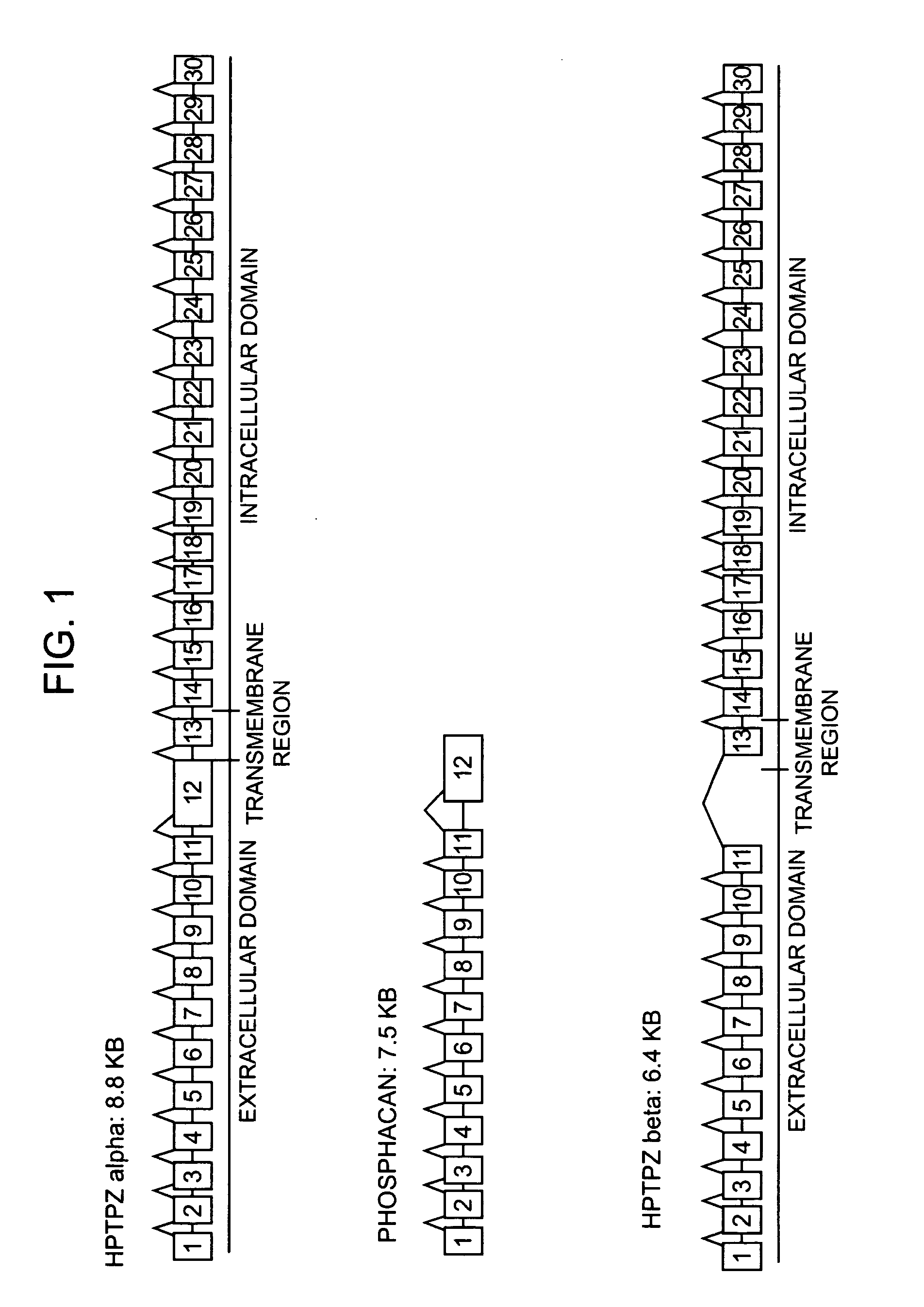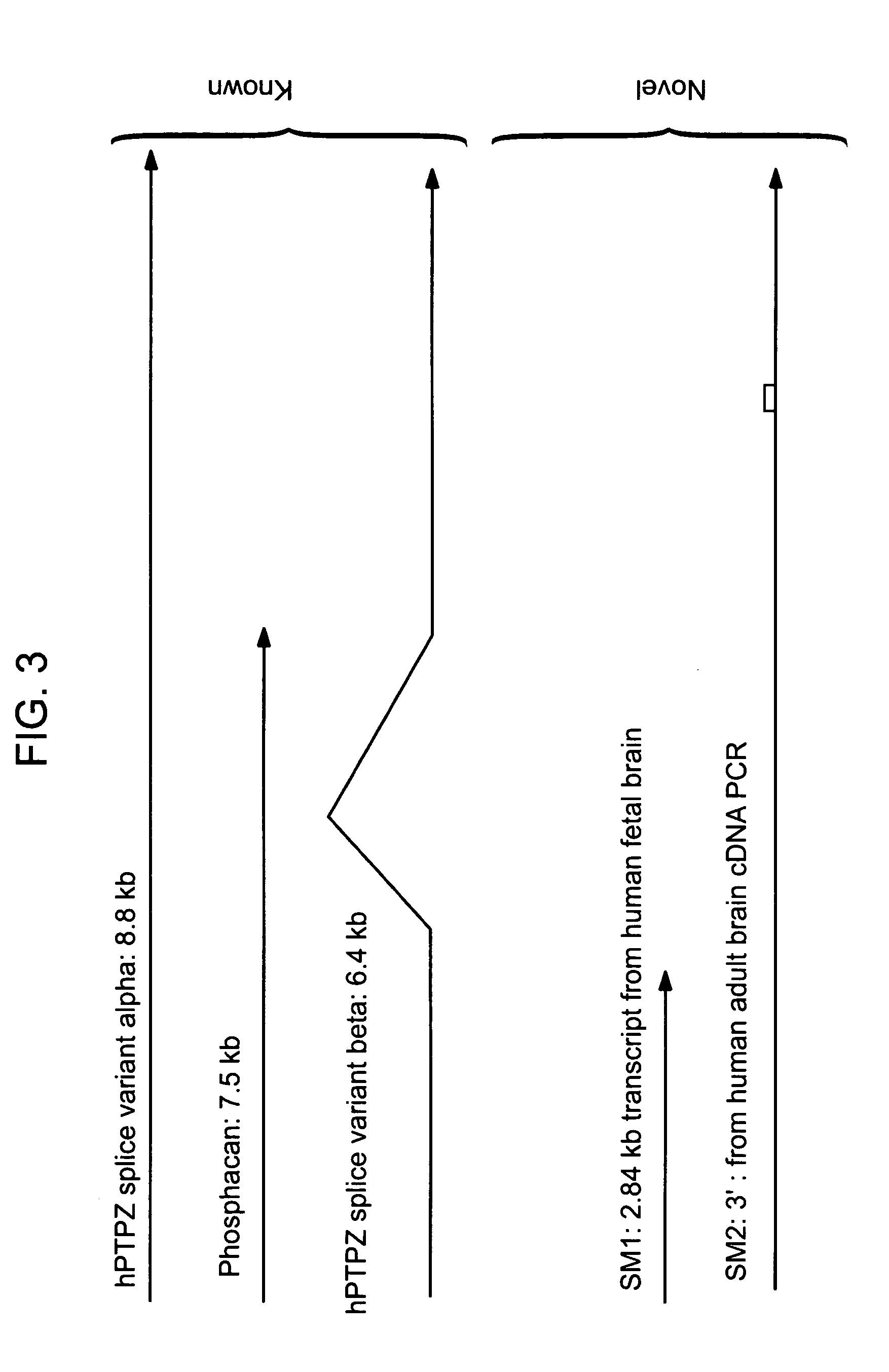Monoclonal antibodies directed to receptor protein tyrosine phosphatase zeta
a technology of tyrosine phosphatase and monoclonal antibodies, which is applied in the direction of antibody medical ingredients, peptides, therapy, etc., can solve the problems of small tumors that can have a profound and adverse effect on the brain's function, damage to the entire organ, and intracrânial space and physical layout of the brain create significant obstacles to treatment and recovery,
- Summary
- Abstract
- Description
- Claims
- Application Information
AI Technical Summary
Benefits of technology
Problems solved by technology
Method used
Image
Examples
example 1
Identification of Two New Splicing Variant Isoforms of PTPζ: PTPζ SM1 and SM2
[0121] The mRNA nucleotide sequence for PTPζ SM1 was identified in a human fetal brain phage cDNA library by sequencing.
[0122] The mRNA nucleotide sequence for PTPζ SM2 was identified by PCR amplification of adult human brain cDNA, and sequencing of the resulting nucleic acids.
[0123] For the RT-PCR analyses performed below, total RNA was isolated from either cells (glioblastoma cultured lines) or tissue using Trizole (Gibco Life Technologies, Inc.), following the manufacture's protocol. cDNA was generated from total RNA using the 1st Strand synthesis kit from Gibco Life Technologies, Inc., and an oligo dT30 anchored primer. For each RT-PCR reaction, 1 μl of cDNA was utilized. The PCR reaction was carried out using an Advantage 2 kit (Clontech) under standard conditions. The products of the PCR reactions were confirmed via sequencing.
[0124] Both clones were verified by RT-PCR analysis of glioblastoma cel...
example 2
Cell Migration Assay For Determining Antibody Activity on Protein Targets
[0128] Tumor cells are known to migrate more rapidly towards chemoattractants. The cell migration assay measures the ability of a cell to migrate. The ability to migrate is taken as a measure of tumorigenicity. Chemoattractants generally used are fetal bovine serum, pleiotrophin, bFGF, and VEGF. Thus, this assay can be used to determine migration capability of a cell in which the gene has been knocked down or the gene of interest is being overexpressed.
[0129] The ChemoTx® disposable chemotaxis system (Neuroprobe, Inc., Gaithersburg, Md.) is used according to the manufacturer's instructions, with a few modifications. Briefly, gliobastoma cultured cells from cell line G55T2 are prepared by splitting the cells the day before the assay is performed. A ChemoTx® chamber with the following specifications is used: Pore size 8 μm, exposed filter area 8 mm2, exposed filter area diameter 3.2 mm. The plate configuration ...
example 3
HUVEC (Human Umbilical Vein Endothelial Cells) Endothelial Sprouting Assay for Determining Antibody Activity on Protein Targets
[0133] Cell-sprouting morphology are utilized as an easily visualized assay to determine the inhibitory effect of a candidate antibody on the protein target function for protein targets which stimulate endothelial cell sprouting, such as PTPζ. Such assays have been described extensively in the literature (Nehls, V., et al., Histochem. Cell Biol. 104: 459-466 (1995); Koblizek, T. I., et al., Curr. Biol. 8: 529-532 (1988); and Kwak, H. J., et al., FEBS Lett. 448: 249-253). Briefly, a endothelial cells from a suitable source, such as HUVECs or PPAECs (porcine pulmonary artery endothelial cells) are grown to confluence on microcarrier (MC) beads (diameter 175 μm, available from Sigma) and placed into a 2.5 mg / ml fibrinogen gel containing the protein target at an appropriate effective concentration (200 ng / ml is an suitable starting concentration, which the skil...
PUM
| Property | Measurement | Unit |
|---|---|---|
| volume | aaaaa | aaaaa |
| volume | aaaaa | aaaaa |
| temperature | aaaaa | aaaaa |
Abstract
Description
Claims
Application Information
 Login to View More
Login to View More - R&D
- Intellectual Property
- Life Sciences
- Materials
- Tech Scout
- Unparalleled Data Quality
- Higher Quality Content
- 60% Fewer Hallucinations
Browse by: Latest US Patents, China's latest patents, Technical Efficacy Thesaurus, Application Domain, Technology Topic, Popular Technical Reports.
© 2025 PatSnap. All rights reserved.Legal|Privacy policy|Modern Slavery Act Transparency Statement|Sitemap|About US| Contact US: help@patsnap.com



